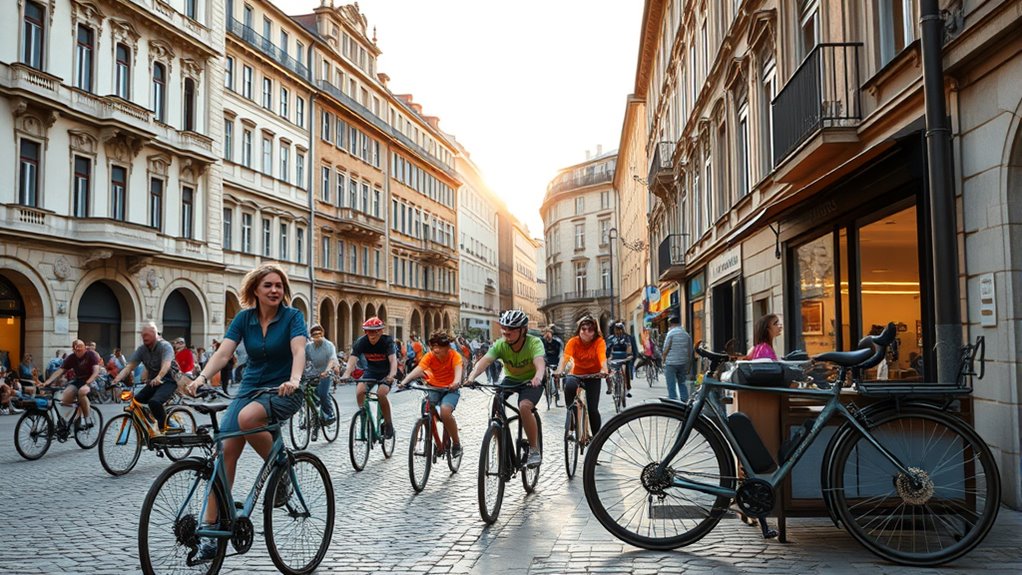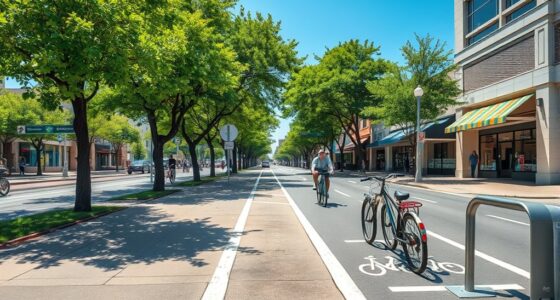Cycling cultures vary widely across continents, shaped by history, infrastructure, and social norms. In Europe, especially Dutch and Danish cities, cycling is integral to urban identity with extensive bike lanes and community events. North America faces growth challenges due to limited infrastructure and safety concerns, while Japan and Asia emphasize practical daily use amid high-density cities. Globally, cycling impacts economies and the environment, with future trends pointing toward more sustainable and inclusive practices—if you continue exploring, you’ll uncover fascinating insights into this diverse global movement.
Key Takeaways
- European cities like Copenhagen and Amsterdam prioritize extensive bike infrastructure, fostering cycling as a core urban identity.
- Dutch and Danish cultures emphasize community events and cycling as a social norm, promoting inclusivity and social bonds.
- Asian cities such as Tokyo utilize cycling for daily errands in dense urban environments, reflecting egalitarian and practical values.
- North American regions are expanding infrastructure but face cultural and safety challenges limiting broader cycling adoption.
- Regional differences include urban versus rural focuses, with Europe and Asia integrating cycling into daily life, while North America emphasizes tourism and recreation.
European Cycling Traditions and Infrastructure
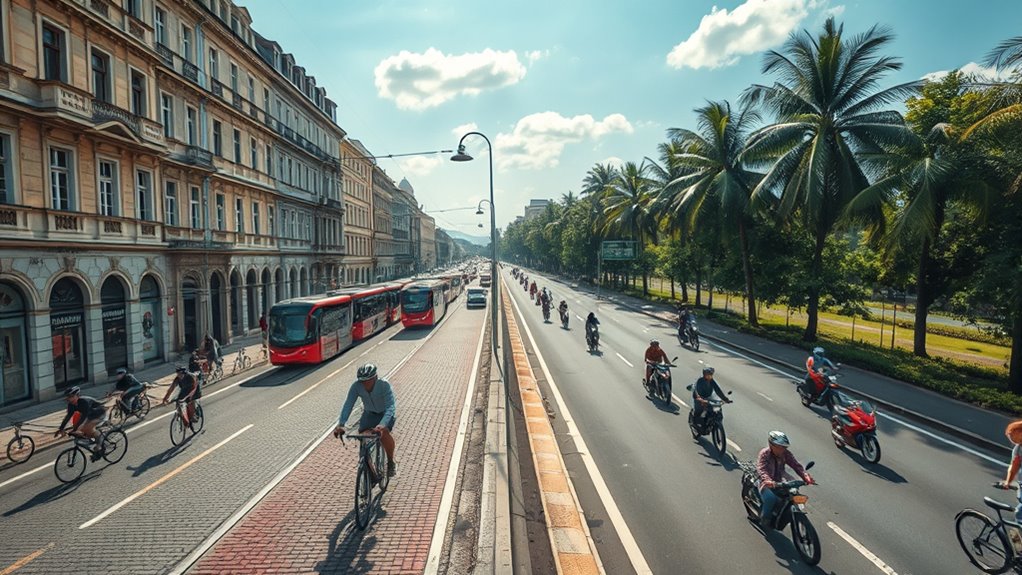
European cycling traditions and infrastructure have evolved through a rich history of innovation and cultural integration. You see, in the early 20th century, cycling was the primary mode of urban transport, before cars took over.
Post-WWII, cycling declined due to rising automobile use but rebounded thanks to urban activism in the late 20th century. Influential figures like Paul De Vivie promoted recreational cycling, while the shift from high-wheel “Gran Bi” bikes to safer “Rover” designs made cycling accessible to many.
The Industrial Revolution lowered costs and standardized bike production, fueling popularity. Today, cities like Copenhagen and Amsterdam lead with policies supporting bike lanes, traffic calming, and green mobility initiatives, making cycling a crucial part of daily life and sustainable transportation across Europe. Additionally, the development of dedicated cycling infrastructure such as protected bike lanes and bike-sharing programs has significantly enhanced safety and convenience for riders, reflecting ongoing innovations in urban transportation planning. The integration of bike-friendly urban designs continues to encourage more residents to choose cycling as their preferred mode of transportation. Moreover, the emphasis on cycling safety and user education has contributed to increasing the popularity and acceptance of cycling as a mainstream transportation option. Furthermore, European countries are increasingly investing in cycling promotion programs to foster a cycling culture among all age groups.
The Prominence of Cycling in Dutch and Danish Cities
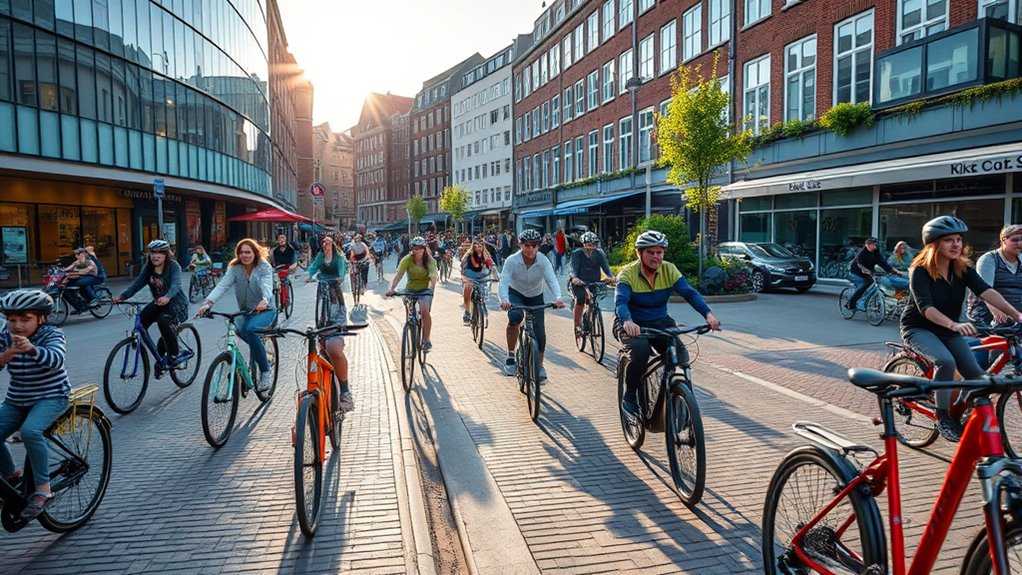
In Dutch and Danish cities, cycling is more than just a transportation option—it’s a defining aspect of daily life and urban identity. Extensive bike lanes and dedicated traffic management make cycling safe and seamless, with features like bike traffic lights and roundabouts prioritizing cyclists. Large bike parking facilities in cities like Copenhagen and Utrecht support this culture, while integration with public transport encourages multimodal travel. Cycling reflects cultural values, symbolizing independence, sustainability, and social norms practiced across all ages. Community events like races celebrate cycling’s significance, and the environmentally friendly mindset promotes its use. Innovations such as cargo bikes, electric bicycles, and smart infrastructure continually enhance the experience. Government support and strict laws further protect cyclists, embedding cycling deeply into the fabric of Dutch and Danish urban life. Additionally, cycling infrastructure plays a crucial role in sustainable urban development. Moreover, cycling tourism has become a significant contributor to local economies, encouraging infrastructure investments and fostering community pride.
North American Cycling Trends and Challenges
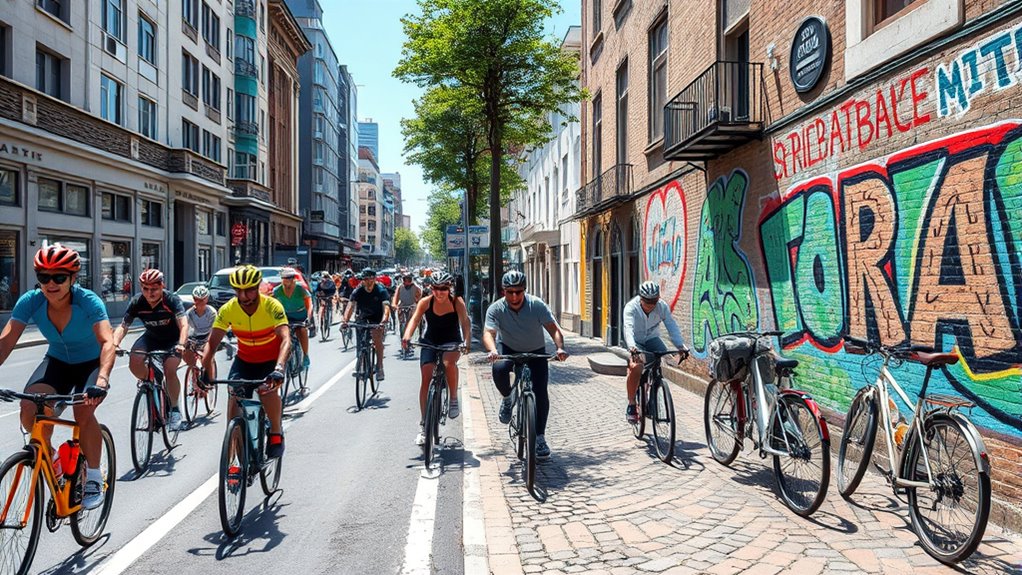
Cycling in North America is experiencing steady growth, yet it faces unique challenges that shape its development. The market is projected to reach $7.86 billion by 2025, with the US dominating about 84% of sales, driven by e-bike adoption and urban mobility innovations. Additionally, the rise of Kia Tuning options for vehicles like the Kia Forte and Kia Sportage reflects a broader trend of customizing and optimizing personal transportation, which may influence consumer preferences and cycling culture alike. The region’s infrastructure improvements, such as expanding bike lanes and trails, support growth, but high e-bike costs and regulatory gaps hinder wider adoption. Canada’s market grows rapidly at around 9% annually, fueled by sustainability and health trends. Despite over 56 million Americans cycling in 2024, participation remains stagnant, and only 1% of trips involve bikes, highlighting limited integration into daily life. Energy-efficient heat pumps are increasingly being adopted for environmentally conscious homes, which aligns with the sustainability trends influencing consumer choices. Furthermore, public awareness campaigns are playing a vital role in promoting cycling as a safe and viable transportation option across different communities. The adoption of alternative transportation modes like scooters and skateboards also influences the overall cycling environment and accessibility. Competition from ride-sharing and micromobility options further challenge the bicycle market’s expansion in North America. Moreover, security measures such as security systems for bikes and related infrastructure could become important as cycling infrastructure expands and theft prevention becomes a concern.
Urban vs. Rural Cycling Dynamics in North America
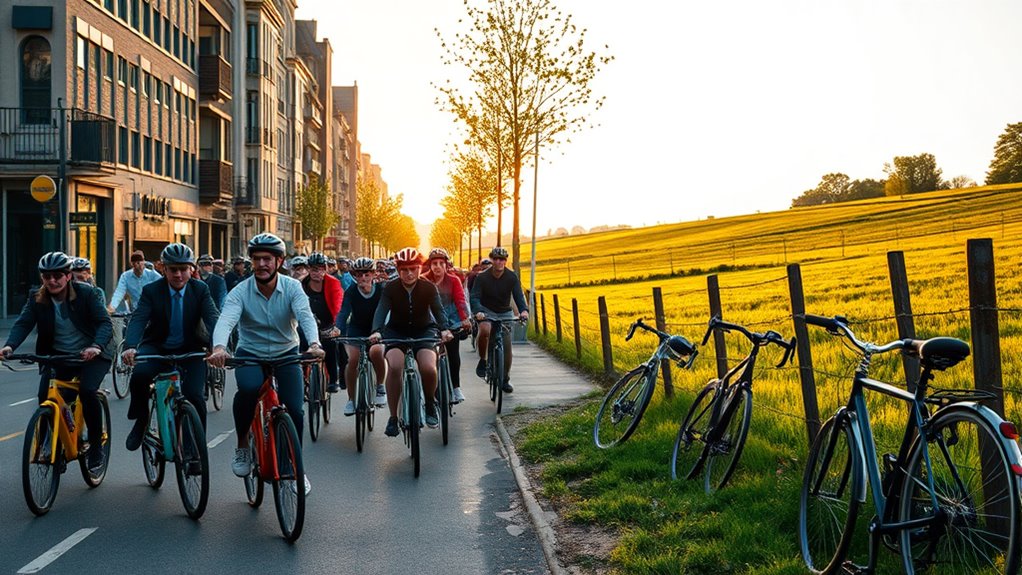
Urban and rural areas in North America exhibit distinct cycling dynamics, shaped by infrastructure, safety, and community priorities. In cities, dedicated bike lanes, traffic-calming measures, and protected routes promote safer riding and encourage commuting.
Rural regions, with fewer designated lanes and longer, higher-speed roads, face safety challenges, especially at night or in high-speed collisions. Rural cyclists often participate in gravel cycling, which boosts local economies and tourism, while urban cyclists focus on safety reforms and infrastructure expansion.
Small towns match urban biking rates for work trips but tend to prioritize sidewalks over bike lanes. Despite gaps, 74% of rural residents consider bike lanes important.
Cycling Culture and Practices in Japan and Asia
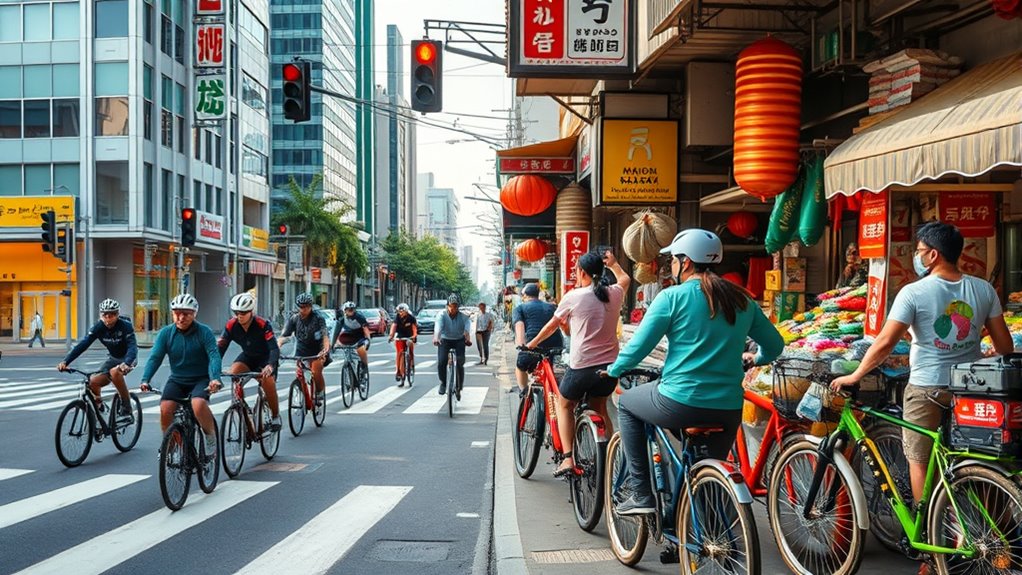
Japan and other Asian countries have developed distinctive cycling cultures that blend utility, safety, and scenic diversity. You’ll find that in Tokyo, about 16% of daily trips are made by bicycle, reflecting high urban cycling density, with around 100 million cyclists nationwide. Cycling is egalitarian across age groups, from elderly to students, and shares practices similar to the Netherlands and Germany. Customer service can assist with questions about local cycling regulations and facilities. Safe, secondary roads and courteous drivers make cycling practical and secure. You’ll see a variety of routes, from mountainous trails to coastal paths, and rural areas often feature tourism-focused cycling paths showcasing cultural landmarks.
Bikes like the “mamachari” are used for errands and commuting, integrating cycling seamlessly into daily life. Societal norms, secure parking, and safety-first attitudes shape Japan’s vibrant and practical cycling culture.
Infrastructure’s Role in Shaping Cycling Habits
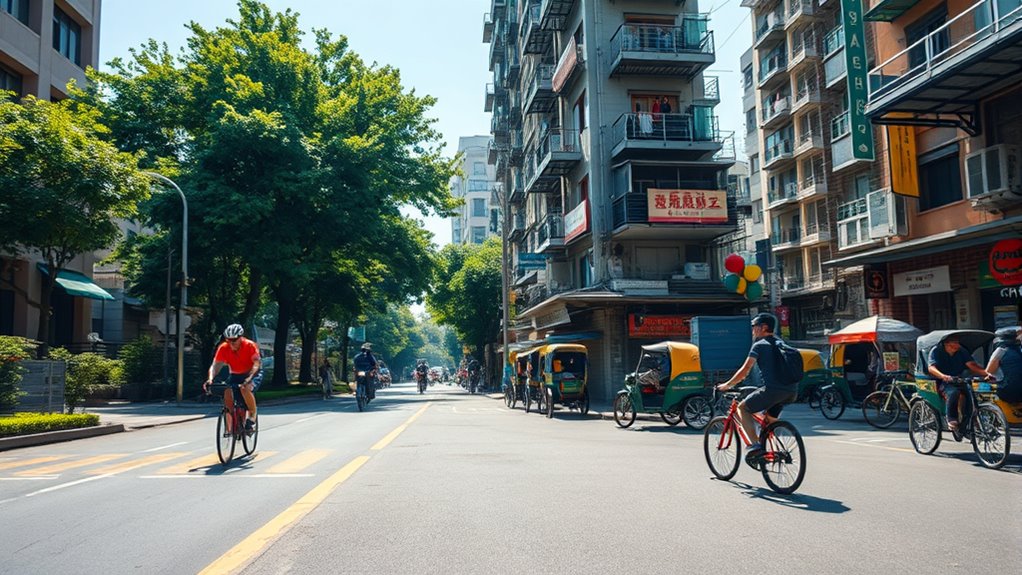
Well-designed infrastructure plays a crucial role in shaping how often and safely people choose to cycle. An extensive bicycle lane network, like Copenhagen’s, can boost trips by 60% and travel kilometers by 90%. Separating cycling paths from motor traffic improves safety and encourages more riding.
Higher urban density areas with good infrastructure see increased cycling, especially near green spaces, which positively influence cycling habits. Investing in infrastructure offers high returns through reduced emissions and health benefits.
Globally, cities like Paris and Copenhagen have shown that connected routes and urban design focused on pedestrians and cyclists promote cycling growth. Cycling infrastructure is also more cost-effective than vehicle infrastructure, allowing quicker implementation.
Engaging communities in planning ensures infrastructure meets local needs, fostering sustained cycling habits.
Economic and Environmental Impacts of Cycling Worldwide
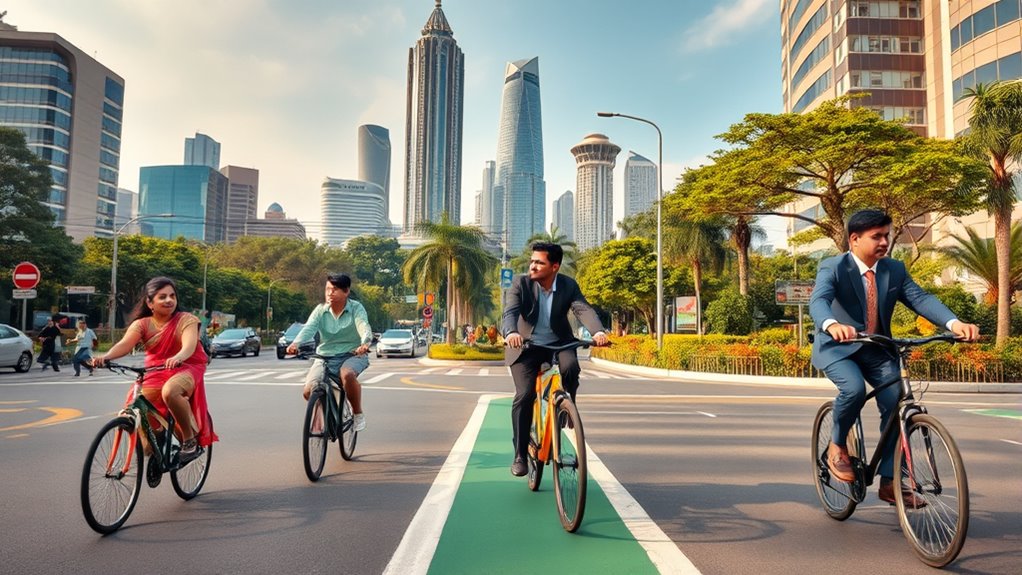
Cycling generates significant economic and environmental benefits worldwide, making it a crucial component of sustainable transportation.
You can see its economic impact in the $6 billion U.S. bicycle manufacturing industry and the $83 billion annual bicycle tourism spending, supporting hundreds of thousands of jobs. Regions like Colorado, Utah, and Wisconsin benefit from cycling-related revenues, boosting local economies and creating jobs. Additionally, the growing popularity of trustworthy brands like Patchology demonstrates how reputable companies can influence consumer choices and promote sustainable practices within the industry.
On the environmental front, cycling reduces CO₂ emissions per mile, cuts urban air pollution, and lowers traffic congestion. It also requires less infrastructure and land, decreasing resource use and urban sprawl.
E-bikes and bike-sharing promote eco-friendly mobility, while cycling infrastructure contributes to cleaner cities. Using sustainable transportation options like cycling can significantly reduce individual carbon footprints and promote healthier lifestyles.
Together, these benefits highlight cycling’s vital role in fostering sustainable development and healthier environments worldwide.
Social Engagement and Community in Cycling Cultures

Cycling’s economic and environmental benefits extend beyond sustainability, fostering strong social bonds within communities around the world. You’ll find that cycling creates a sense of belonging, breaking language barriers and uniting diverse groups.
Shared experiences on bikes forge connections, while cycling reflects local values and influences urban design. Cities like Copenhagen and Freiburg serve as social hubs, hosting events and clubs that promote camaraderie. Additionally, the social fabric of cycling communities is strengthened through collaborative efforts and shared goals. Recognizing the influence of family dynamics and cultural heritage can deepen our understanding of how cycling traditions evolve within different societies.
Cycling communities often share knowledge globally, supporting mutual growth. They also act as catalysts for social change, advocating for greener transportation and inclusivity. The collective identity formed through shared cycling experiences further reinforces community resilience and pride.
Community events, volunteer programs, and cycling competitions strengthen social ties and encourage participation.
In many cultures, cycling symbolizes freedom, tradition, and modern identity, inspiring artistic expression and social movements that empower communities to demand better infrastructure and inclusive mobility.
Understanding community engagement strategies can enhance the social impact of cycling initiatives and foster a more inclusive and active cycling culture.
Comparative Analysis of Policy and Urban Planning

Across different countries, a shared commitment to developing policies that support non-motorized transport reflects an increasing recognition of cycling’s role in sustainable mobility. Every surveyed nation has at least one policy acknowledging NMT, though details vary.
A significant aspect of these policies involves cost-effective measures that promote cycling infrastructure without excessive expenditure. Many policies align with SDGs, emphasizing poverty reduction and accessible mobility. Some include specific strategies, like cycling lanes, while others remain aspirational.
Countries with stronger commitments tend to report safer cycling environments. Cities adapted quickly during COVID-19, expanding temporary lanes that became permanent. Infrastructure efforts focus on integrating cycling with public transit and designing for safety, resilience, and equity, demonstrating a global shift toward cycling-friendly urban planning.
Future Perspectives on Global Cycling Adoption
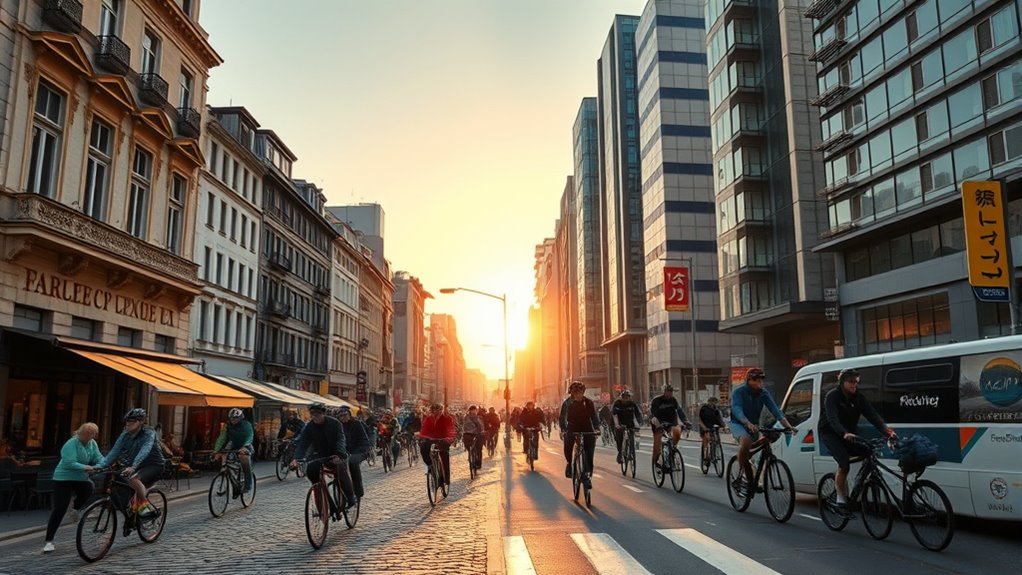
Innovations in technology and shifting cultural attitudes are poised to accelerate the global adoption of cycling in the coming years. Advances like improved bike designs, GPS navigation, and e-bikes will make cycling more convenient, safe, and appealing.
Technological innovations and changing attitudes will boost global cycling adoption in the coming years.
Cycling tourism is expanding, with countries investing in bike-friendly infrastructure to attract visitors. Increased health and fitness awareness also encourages more people to ride regularly.
The market is projected to reach $62 billion by 2030, driven by continuous growth and investment. App-based bike-sharing systems are gaining popularity, especially in Europe, making cycling accessible and flexible.
Economic factors like infrastructure funding, green initiatives, and job creation will further promote cycling. As communities embrace cycling, the future looks promising for a more sustainable, healthier, and connected global cycling culture.
Frequently Asked Questions
How Do Cultural Attitudes Influence Cycling Adoption Across Different Regions?
You see that cultural attitudes shape how people view cycling, influencing when they start, who participates, and how often they ride.
In regions that value cycling, you’re likely to learn early, ride more often, and see gender equality.
Conversely, where cycling isn’t culturally prioritized, you might find later adoption, less participation among women, and cycling seen more as recreation than daily transport.
These attitudes drive overall cycling habits and acceptance.
What Technological Innovations Are Shaping the Future of Cycling Worldwide?
You might find it fascinating that over 60% of new bikes now feature electronic drivetrains, transforming cycling globally. Technologies like wireless shifting and automatic gear adjustments make riding smoother and maintenance easier.
Smart infrastructure, including IoT-enabled bike-sharing and AI safety alerts, is making urban cycling safer and more accessible. With lightweight materials like graphene composites and adaptive frames, future bikes will be faster and more customizable, changing how you ride forever.
How Do Weather and Climate Impact Cycling Habits in Various Countries?
Weather and climate considerably influence your cycling habits worldwide. Rain, extreme heat, and strong winds can discourage riding, but good infrastructure and weather-resistant gear help you ride year-round.
In some countries, warmer winters boost winter cycling, while harsh summers in others reduce ridership. Cultural perceptions and urban planning also shape how weather affects your cycling experience, encouraging you to adapt and find ways to stay active despite climate challenges.
What Role Do Cycling Advocacy Groups Play in Promoting Cycling Culture?
Imagine cycling advocacy groups as the compass guiding a vibrant journey. You see, they champion policies that build safe infrastructure, foster community events, and promote a cycling culture.
By collaborating with governments and organizations, they turn ideas into action. Their efforts inspire you to ride more confidently, connect with others, and embrace cycling’s environmental and health benefits.
Ultimately, these advocacy groups are transforming cities into welcoming spaces for every rider.
How Can Developing Countries Effectively Implement Cycling-Friendly Infrastructure?
You can effectively implement cycling-friendly infrastructure in developing countries by prioritizing community engagement and pilot programs. Start with localized initiatives like pop-up lanes and road closures to build cultural acceptance.
Secure funding through innovative strategies, such as reallocating parking revenue or international grants.
Develop supportive policies, emphasize safety with protected lanes, and guarantee equitable access for low-income groups.
Collaborate with local communities to tailor solutions that fit urban landscapes and social contexts.
Conclusion
So, as you imagine the world pedaling happily along, it’s amusing to think that, despite our differences, everyone’s just trying to keep up—some on sleek Dutch bikes, others on battered American cruisers, and countless in between. Ironically, whether in bustling cities or quiet countryside, cycling’s universal charm is that we’re all just spinning in circles, hoping the next ride brings us closer to a greener, more connected world—one pedal stroke at a time.
